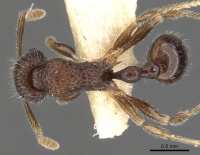Tetramorium etiolatum
| Tetramorium etiolatum | |
|---|---|

| |
| Scientific classification | |
| Kingdom: | Animalia |
| Phylum: | Arthropoda |
| Class: | Insecta |
| Order: | Hymenoptera |
| Family: | Formicidae |
| Subfamily: | Myrmicinae |
| Tribe: | Crematogastrini |
| Genus: | Tetramorium |
| Species: | T. etiolatum |
| Binomial name | |
| Tetramorium etiolatum Bolton, 1977 | |
Nothing is known about the biology of Tetramorium etiolatum.
Identification
Bolton (1977) - The long, narrow, downcurved propodeal spines characteristic of most species of the ornatum-group are very well developed in etiolatum, but this species is quickly differentiated from most of its relatives by the possession of relatively long antennal scapes, which in etiolatum have SI range 96-101 compared with the usual range of about 80-90 in most of the group. The only species with SI outside this range is Tetramorium politum (SI 105) but here the head is mostly unsculptured whereas in etiolatum the head is sculptured everywhere.
Distribution
Latitudinal Distribution Pattern
Latitudinal Range: -6.500046° to -6.500046°.
| North Temperate |
North Subtropical |
Tropical | South Subtropical |
South Temperate |
- Source: AntMaps
Distribution based on Regional Taxon Lists
Indo-Australian Region: New Guinea (type locality).
Distribution based on AntMaps
Distribution based on AntWeb specimens
Check data from AntWeb
Countries Occupied
| Number of countries occupied by this species based on AntWiki Regional Taxon Lists. In general, fewer countries occupied indicates a narrower range, while more countries indicates a more widespread species. |

|
Estimated Abundance
| Relative abundance based on number of AntMaps records per species (this species within the purple bar). Fewer records (to the left) indicates a less abundant/encountered species while more records (to the right) indicates more abundant/encountered species. |

|
Biology
Castes
Nomenclature
The following information is derived from Barry Bolton's Online Catalogue of the Ants of the World.
- etiolatum. Tetramorium etiolatum Bolton, 1977: 105, fig. 29 (w.q.m.) NEW GUINEA.
Unless otherwise noted the text for the remainder of this section is reported from the publication that includes the original description.
Description
Worker
Holotype. TL 3.4, HL 0.76, HW 0.66, CI 87, SL 0.66, SI 100, PW 0.52, AL 0.96.
Mandibles striate. Anterior clypeal margin convex, entire, with a narrow anterior flange or apron. Frontal carinae extending back beyond the level of the posterior margins of the eyes but weak, no more strongly developed than the other sculpture on the dorsum of the head. Behind the level of the eyes the frontal carinae petering out, their place taken by other constituents of the sculpture or, in some of the type-series, interrupted or broken in places. Antennal scrobes scarcely noticeable, the antennal scapes relatively long (SI in entire type-series 96 or more). Maximum diameter of eye c. 0.14. Propodeal spines very long, narrow and acute, distinctly downcurved along their length. Metapleural lobes triangular. Petiole in profile with a long, curved anterior peduncle and a long, low node, the dorsal length of the node greater than the height of the tergal portion, the dorsum evenly but shallowly convex. Posteriorly the dorsum rounds evenly into the posterior face, the two not separated by an angle. Post petiole in profile dome-shaped. Clypeus with five main longitudinal carinae and also with traces of other incomplete and more feebly developed carinae. Dorsum of head strongly sculptured with longitudinal carinate rugae, most of which are feebly sinuate or meandering. Cross-meshes are not developed and the ground sculpture between the rugae consists of very shallow superficial punctures which are inconspicuous. Dorsal alitrunk weakly reticulate-rugose, the reticulum broken down or disorganized in places. Petiole with scattered vestiges of rugose sculpture, postpetiole and gaster unsculptured. All dorsal surfaces of head and body with numerous fine soft hairs, those on the dorsal (outer) surface of the hind tibiae short and curved. Colour uniform blackish brown, the appendages lighter, mid-brown.
Paratypes. TL 3.2-3.7, HL 0.7-0.80, HW 0.62-0.68, CI 84-89, SL 0.60-0.68, SI 96-101, PW 0.48-0.54, AL 0.90-1.00. Maximum diameter of eye c. 0.14-0.16 (16 measured). As holotype but with variation in development of frontal carinae noted above. A few specimens have the legs a paler brown than in the holotype.
Type Material
Holotype worker, New Guinea: Mongi Watershed, Huon Pen., Gemeheng, 11-13.iv.1955, 1300 m, no. 785 (E. O. Wilson) (Museum of Comparative Zoology). Paratypes. New Guinea: 9 workers and 2 females (1 alate) with same data as holotype; 2 workers, 2 females (alate) and 2 males, Mongi Watershed, Huon Pen., Ebabaang, 16-18.iv.1955, 1300-1400 m, no. 817 (E. O. Wilson); 5 workers and 1 female (dealate) with same data as last but no. 838 (E. O. Wilson); 2 workers, Mongi Watershed, Huon Pen., Tumnang, 14-15.iv.1955, 1500 m, no. 798 (E. O. Wilson) (Museum of Comparative Zoology; The Natural History Museum).
References
- Bolton, B. 1977. The ant tribe Tetramoriini (Hymenoptera: Formicidae). The genus Tetramorium Mayr in the Oriental and Indo-Australian regions, and in Australia. Bulletin of the British Museum (Natural History). Entomology. 36:67-151. (page 105, fig. 29 worker, queen, male described)
References based on Global Ant Biodiversity Informatics
- Bolton B. 1977. The ant tribe Tetramoriini (Hymenoptera: Formicidae). The genus Tetramorium Mayr in the Oriental and Indo-Australian regions, and in Australia. Bulletin of the British Museum (Natural History). Entomology 36:67-151.
- Bolton, B. "The ant tribe Tetramoriini (Hymenoptera: Formicinae. The genus Tetramorium Mayr in the Oriental and Indo-Australian regions and in Australia." Bulletin of the British Museum (National History): Entomology series 36, no. 2 (1977): 68-151.
- Janda M., G. D. Alpert, M. L. Borowiec, E. P. Economo, P. Klimes, E. Sarnat, and S. O. Shattuck. 2011. Cheklist of ants described and recorded from New Guinea and associated islands. Available on http://www.newguineants.org/. Accessed on 24th Feb. 2011.

